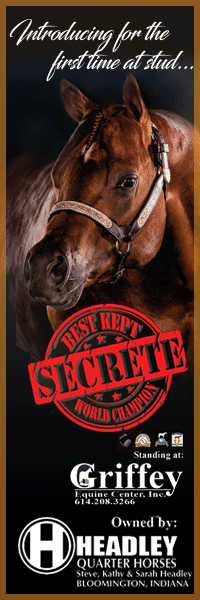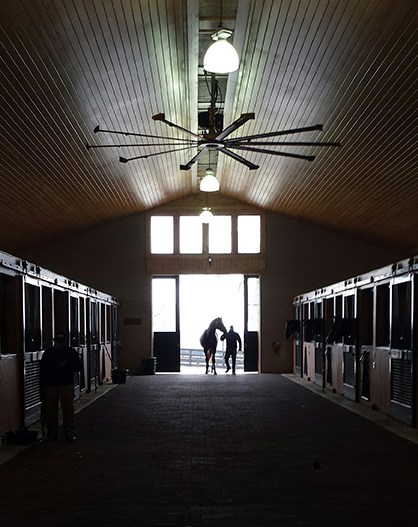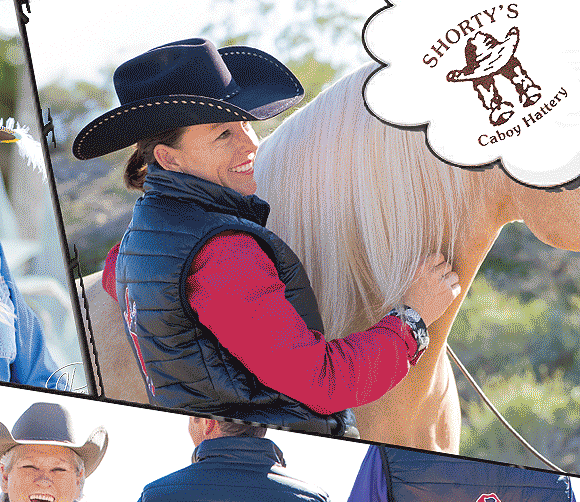Horizon Structures Presents Series- Finishing Touches for Your New Barn
by: Horizon Structures, LLC- Nikki Alvin-Smith
The day has finally arrived and your new horse barn is ready to use. The smell of fresh shavings, the aroma of new wood and the promise of many happy hours to come in the company of your favorite equines are on the horizon.
Before you invite your wee equine beasties inside, there are a few finishing touches to consider. Here are a few ideas to think about adding to put the final finishing touches on your wonderful new building:
Seal the Surfaces
Before your horse poops against the clean wall or scrapes his teeth on the kickboards, it is a good idea to seal the walls with a horse safe product. This will facilitate easier clean down and promote hygiene when you need to disinfect or clean stalls later.
Safety Front and Center
If you have a center aisle barn, think about the safety of using the valuable center space. If the floor is dirt, adding shavings to it may look pretty, but these create not just a fire hazard, but also a great place to lose small items around the barn such as horseshoe studs, hoof picks, keys etc. As you hay up your horses, the center aisle will quickly become messy and hard to tidy up. Think about adding some stonedust and have it compacted for best results. This will pack down and also prevent horses that are on the crossties from poring the ground and making holes.
If the center aisle is concrete, you should add mats to avoid your horse slipping when turning in and out of stalls or during periods of excitement. Rubber mats can be used, or if you have the budget, pavers that have some rubber content are great. The aisle can then be swept or vacuumed clean.
For a shedrow style barn, the addition of a gravel base with a stonedust topping that slopes away from the building is a must in high traffic areas around the building. This will help alleviate mud issues later and it is best done before that problem is created by use of the building.
Cross Ties
The use of cross ties in a center aisle barn is very popular in America. In Britain, where I grew up, horses were tethered to a ring on the back wall of their stall for grooming, so on arrival in the USA I found these ties unconventional. What I have learned is that no matter how trained to the cross ties, your horse may appear to be the cross ties can wreak havoc in a second. Horses can spook and then panic at the cross tie contact; other horses can get loose in the barn and plow through the ties and become entangled; horses can back up and then panic or plow forward and do the same. I knew a clinic student who had her finger ripped from her hand when the farrier was working on her warmblood’s feet and he panicked and she reached for the emergency clip. I have seen horses hit in the head causing injury when they pulled away from the tie and the metal end snapped them on the forehead, horses running free with their legs tangled in nylon straps etc. So use cross ties wisely!
It is imperative that the cross ties are set high enough on the wall for the specific horses that use them and that they are securely attached to the wall or post. They should have emergency clips where they attach to the halter.
When tying horses, it is a good idea to use baling twine where the halter meets the cross tie so that if a panic situation arises the twine will break. Never attach a cross tie to a bit ring on a bridle.
My personal favorite design of cross tie is one that has a quick release snap at both ends, and has a 3 strap velcro connection about a foot from the horse end of line. This will not only give way in an emergency, but the horse will not have a trailing piece of cross-tie to tangle in his legs if he takes flight. On a side note, for the same reason the 3 strap velcro is my favorite type of side rein when training horses to longe.
Signage
At a minimum, you should post signage regarding Inherent Risk Law for your State, and the requirement to wear head protection for riders when mounted and emergency contact lists for fire/police/EMT/vets etc. In my barn, I also have a sign with emergency treatment protocols for choking/heart attack etc.
It is important that you have phone access from your barn to emergency services. If you do not have cell service availability at your barn, addition of a land line may be old fashioned but it is a prudent measure to take.
Other signs that are particularly useful for boarding barns are wipe down stall memo boards for grain/turn out instructions on stall doors; signs requesting aisleway floor be swept clean and hoses be rolled up or put away after use; a large white board or blackboard to leave notes and barn rule notices.
First Aid Kit
There should be a first aid kit for horses and for humans and it needs to be easily accessible and clearly visible. Whether you are a backyard owner or a professional boarding entity, this is of paramount importance.
Security
When horses are outside, it is safe to lock the barn, and this is particularly important if you store expensive tack items in the building that are not under a separate lock and key or security door system.
For peace of mind, it is also beneficial to install a security camera system. These systems can be purchased relatively inexpensively and linked to your cell phone via an app so you can view your barn in real time when you are elsewhere.
Keeping Your Barn Cool
You may have planned ahead and added electrical outlets between each stall for easy access for your vet when the need for a power source for diagnostic equipment arises or for your use for a horse vacuum, clippers etc. When summer arrives and you’d like to add fans for extra cooling for your stabled equines, do not be tempted to buy a regular fan from the local big box store and strap it to the front grill of the stall. Always purchase a commercial grade fan that is rated for use in an indoor/outdoor environment with proper case protection for the blades, and be certain the electric cable is out of reach of any prying horse noses and that both cable and fan are out of a young child’s reach. Always keep your fans clean and free of debris so that you do not create a fire hazard.
Keeping Your Barn Warm
My best advice is to keep the doors shut. If you add a rocket heater or other flame heat source, you are asking for trouble. The highly flammable environment of a horse barn is not a place to have any type of open flame. An electric heater such as an infra-red heater placed in an office or tack room as a place to warm up should only be used when you are present to monitor it.
Fly/Mosquito Systems
These systems can be very useful in areas of high fly and bug populations. Consult with a professional as to their use around horses especially where they are installed over stalls where hay and grain may be provided. You do not want your horse ingesting the repellents along with his food.
Sprinkler Systems
I’m sure we’d all like one of these in our barn, but they are expensive and difficult to use without having a heated barn in winter, due to freeze issues. If you can afford it, go for it! Consult a professional who has experience working in an equine environment.
Fire Extinguishers
Obviously, these are a must have, and it is important they are properly maintained. For larger barns, at a minimum, place one by each entrance of the building.
Exit Signs
These should be lit and placed above each exit and are required by law in some instances especially in public/commercial buildings.
Temporary Tack/Equipment Storage
A bridle hook to hang a halter and rope/bridle by each stall is very useful and these should be blunt edged or rubber to ensure safety. When tacking up it is useful to have a collapsible saddle rack on the outside of a stall wall or a saddle-stand in the aisleway. Again, the saddle stand should be blunt edged to avoid injury to horse or human.
For blankets, the ideal situation is a tall wall glide system that hangs the blankets at full length. However, not everyone has room for this luxury. Blanket bars can be fabricated out of plumbing pipe on stall doors, or a rubber coated chain can be hooked onto the outside of the stall door.
Storage
For feed and tack storage, you will ideally have a separate room. Tack trunks can be utilized in the aisle of the barn or under the lee of an overhang. Be careful that the trunks do not pose an obstruction hazard or create a narrow aisleway.
Medicines of any type should be stored at the right temperature and secured away from inquisitive children or pets.
Your barn should be your happy place. Finishing touches that offer safety, are functional and make your barn your own are exciting to add.
This article is brought to you courtesy of Horizon Structures Inc., Atglen PA – Modular horse barn and indoor riding arena specialists. Please visit https://www.HorizonStructures.com to learn more.
About Horizon Structures: One horse or twenty, there’s one thing all horse owners have in common…the need to provide safe and secure shelter for their equine partners. At Horizon Structures, we combine expert craftsmanship, top-of-the-line materials and smart “horse-friendly” design to create a full line of sheds and barns that any horse owner can feel confident is the right choice for their horses’ stabling needs.
All wood. Amish Made. Most of our buildings are shipped 100% pre-built and ready for same-day use. Larger barns are a modular construction and can be ready for your horses in less than a week. All our barn packages include everything you need –
Horizon Structures also sells indoor riding arenas, chicken coops, dog kennels, 1 and 2 car garages, storage sheds and outdoor living structures.
Headquartered in South-Central Pennsylvania, Horizon Structures, LLC is owned by Dave Zook. Dave was raised in the Amish tradition and grew up working in the family-owned shed business. He started Horizon Structures in 2001 in response to an ever-increasing customer demand for high quality, affordable horse barns.
For additional information about the company or their product line, please visit their website at https://www.horizonstructures.com.












